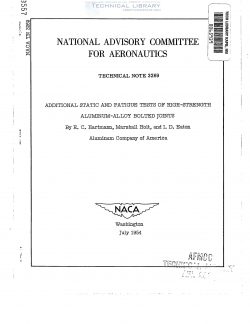naca-tn-3269
- Version
- 97 Downloads
- 1.44 MB File Size
- 1 File Count
- January 23, 2017 Create Date
- January 23, 2017 Last Updated
National Advisory Committee for Aeronautics, Technical Notes - Additional Static and Fatigue Tests of High Strength Aluminum Alloy Bolted Joints

Additional static and fatigue tests were made on a few types of
Joints in 75S-T6, EHS—Th, and th-TS high-strength aluminum-alloy
extruded bar in order to supplement the data in NACA Technical the 2276.
Comparisons are made with the results of these earlier tests.
A Joint of a new design, stepped double—shear Joint, in 75S-T6
aluminum alloy was found to have an intermediate fatigue life when com-
pared with the other Joint designs used in this investigation. At like
loading conditions, the stepped double-shear Joint withstood fewer
fatigue cycles than either the plain double—shear Joint or the double-
scarf Joint, but its fatigue life exceeded that of all the other Joint
designs used. This new Joint had the same net-section area as that of
the other Joints tested.
For three Joint designs studied in 75S-T6, 211-S-T1L, and th-T6
aluminum alloys, no one alloy gave consistently greater fatigue life at
the stress ranges studied. The plain—scarf Joint in ens—Tu gave consist-
ently higher fatigue life than did the plain-scarf Joint in 75S—T6 by
ratios ranging from l.h:l to 18.5:1; there was no significant difference
in the fatigue lives of the nonuniform-step Joints in the three alloys;
and the 75S-T6 aluminum-alloy double—shear Joint gave a greater fatigue
life than did either the ens—Tl; or 1hS—T6 double—shear Joints by ratios
of I.5:l and 2.5:1, respectively.
When the load ranges of the plain-scarf Joint in 21l-S-T1L and 75S-T6
are adjusted to take account of the difference in static strengths of
the Joints, the fatigue life of the Ens-Th aluminum-alloy Joint exceeds
that of the 75S—T6 Joint by ratios of about 5:1 and 12:1 for the O and
0.2 stress ratios, respectively; The adjustment leads to a mean load of
16,000 pounds for the 7SS-T6 Joint and 15,600 pounds for the 2hS—Tfi Joint.
If the comparisons are made on the basis of either the specified tensile
strengths of the alloys or the actual tensile strengths of the materials
rather than the static strengths of the Joints, the ratios of fatigue
lives are as high as 16.6:1.
| File | Action |
|---|---|
| naca-tn-3269 Additional Static and Fatigue Tests of High Strength Aluminum Alloy Bolted Joints.pdf | Download |

Comment On This Post